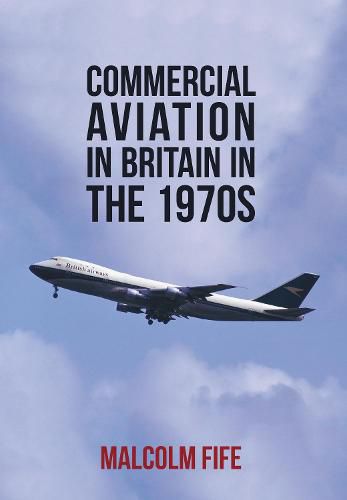Readings Newsletter
Become a Readings Member to make your shopping experience even easier.
Sign in or sign up for free!
You’re not far away from qualifying for FREE standard shipping within Australia
You’ve qualified for FREE standard shipping within Australia
The cart is loading…






In the decades leading up to the 1970s, passenger air transport was the preserve of the well-to-do who flew on airliners driven by propellers. Over the next few years all this was about to change. The passenger air transport industry underwent a great transformation with the introduction of many innovations that established the foundations for today.
The state airlines, BEA and BOAC, were merged to form British Airways in 1974. Throughout the decade they were far and away the most important operator of scheduled services in the country. To provide competition, however, the independent carrier British Caledonian was created.
The first Boeing 747 jumbo jet was delivered to BOAC in 1970. This wide-body airliner enabled fares to be reduced and opened up air travel to many people who could not previously afford it. Laker Airways pioneered the concept of the low-cost airline. It was the first British independent airline to operate wide-bodied jets in the form of DC-10s, which entered service in 1972. Most of the other British independent airlines had to make do with a motley collection of old airliners, many of them turboprops. The charter and holiday market was the main market for a large number of these carriers. They were regular visitors to the main airports throughout Britain, particularly at weekends.
There were, however, few scheduled passenger air services to foreign countries from airports other than Heathrow and Gatwick. Almost all were either flown by British Airways or a state-owned carrier from another country. Overseas independent airlines, like their British equivalents, generally only served the holiday market.
In this book, Malcolm Fife uses his excellent collection of colour photographs to illustrate the airliners in commercial use that could be seen at airports during the 1970s.
$9.00 standard shipping within Australia
FREE standard shipping within Australia for orders over $100.00
Express & International shipping calculated at checkout
In the decades leading up to the 1970s, passenger air transport was the preserve of the well-to-do who flew on airliners driven by propellers. Over the next few years all this was about to change. The passenger air transport industry underwent a great transformation with the introduction of many innovations that established the foundations for today.
The state airlines, BEA and BOAC, were merged to form British Airways in 1974. Throughout the decade they were far and away the most important operator of scheduled services in the country. To provide competition, however, the independent carrier British Caledonian was created.
The first Boeing 747 jumbo jet was delivered to BOAC in 1970. This wide-body airliner enabled fares to be reduced and opened up air travel to many people who could not previously afford it. Laker Airways pioneered the concept of the low-cost airline. It was the first British independent airline to operate wide-bodied jets in the form of DC-10s, which entered service in 1972. Most of the other British independent airlines had to make do with a motley collection of old airliners, many of them turboprops. The charter and holiday market was the main market for a large number of these carriers. They were regular visitors to the main airports throughout Britain, particularly at weekends.
There were, however, few scheduled passenger air services to foreign countries from airports other than Heathrow and Gatwick. Almost all were either flown by British Airways or a state-owned carrier from another country. Overseas independent airlines, like their British equivalents, generally only served the holiday market.
In this book, Malcolm Fife uses his excellent collection of colour photographs to illustrate the airliners in commercial use that could be seen at airports during the 1970s.